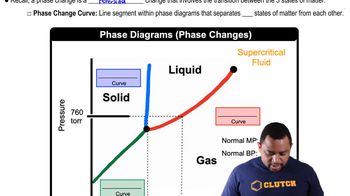Ch.1 - Matter, Measurement & Problem Solving

Chapter 1, Problem 144
The diagram shown first represents solid carbon dioxide, also known as dry ice. Which of the other diagrams best represents the carbon dioxide after it has sublimed into a gas?
 Verified step by step guidance
Verified step by step guidance1
Understand that sublimation is the process where a solid turns directly into a gas without passing through the liquid phase.
Recognize that solid carbon dioxide (dry ice) consists of CO₂ molecules closely packed in a regular pattern.
When CO₂ sublimates, the molecules gain energy and move apart, transitioning from a solid to a gaseous state.
In the gaseous state, CO₂ molecules are far apart and move freely, unlike in the solid state where they are tightly packed.
Identify the diagram that shows CO₂ molecules spread out and moving freely, representing the gaseous state after sublimation.
Key Concepts
Here are the essential concepts you must grasp in order to answer the question correctly.
Sublimation
Sublimation is the process in which a solid transitions directly into a gas without passing through the liquid phase. This occurs when the molecules in the solid gain enough energy to overcome intermolecular forces, allowing them to escape into the gas phase. Dry ice, or solid carbon dioxide, sublimates at temperatures above -78.5°C, making it a common example of this phenomenon.
Recommended video:
Guided course

Sublimation Phase Change Example
States of Matter
Matter exists in different states, primarily solid, liquid, and gas, each characterized by distinct properties. In solids, particles are closely packed and vibrate in place; in liquids, they are less tightly packed and can flow; in gases, particles are far apart and move freely. Understanding these states is crucial for visualizing how substances like carbon dioxide change form during processes like sublimation.
Recommended video:
Guided course

Element States of Matter
Phase Diagrams
Phase diagrams are graphical representations that show the states of a substance at various temperatures and pressures. They illustrate the conditions under which a substance exists as a solid, liquid, or gas, and the transitions between these states. For carbon dioxide, the phase diagram helps predict the behavior of the substance under different environmental conditions, including the sublimation process.
Recommended video:
Guided course

Phase Changes in Diagrams
Related Practice
